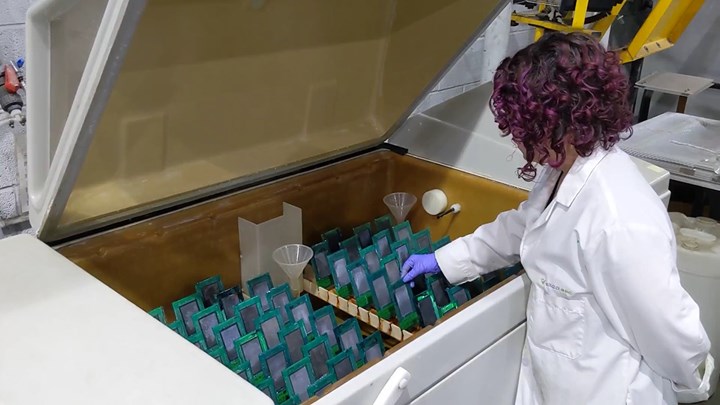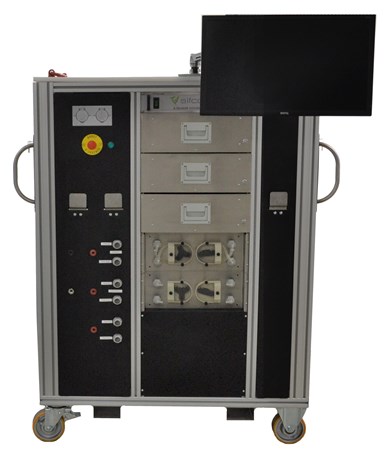
Corrosion protection relies heavily on testing, which produces a great deal of data that needs to be analyzed.
Photo Credit: All photos courtesy of SIFCO ASC
The shutdown and failure of equipment due to corrosion can cause major setbacks for any industry, especially when experiencing equipment failure or replacement, leading to loss of productivity and efficiency. This is why comprehensive research is undertaken to identify the effects and risks of corrosion to better understand which types of metals are most likely to be affected as well as developing the best preventative measures to reduce corrosion.
The challenges facing engineering, manufacturing and aerospace
There are a variety of challenges when it comes to preventing corrosion, especially when working in hot and humid environments. Simply forgetting to wipe off chemicals or cleaning equipment can result in issues. However, having a proper maintenance schedule, which includes keeping both machine and equipment clean as well as being situated within an air-conditioned environment, will extend equipment and machine life.
As well as being economically important, there is the additional sustainability issue when it comes to corrosion protection. While accounting for depreciation might set the expected lifetime for a certain number of years for a specific piece of equipment or component, by adding corrosion protection, you can further extend that lifetime, which is far more sustainable than replacement.
Types of metal at risk of corrosion
Carbon and high-strength steels are very susceptible to corrosion because these alloys have been designed primarily for strength and lack the chromium content found in stainless steels that prevent corrosion. The aerospace industry is a prime example of the necessity of corrosion prevention, due to the wide variety of environments that materials are exposed to, especially the high-strength steel landing gears on planes. With this type of steel, hydrogen embrittlement adds an element of risk. Another alternative electroplated deposit for corrosion protection is tin zinc, however, one of its disadvantages is it has less optimum wear properties when compared to zinc nickel.
Corrosion protection relies heavily on testing, and it produces a great deal of data that needs to be analyzed. This research helps to benefit businesses within engineering and manufacturing sectors, including the aerospace industry. R&D departments regularly work on different projects and corrosive scenarios. For example, one major product that the team at SIFCO ASC is involved with is a cadmium replacement technology — a zinc nickel alloy. The two primary forms of corrosion that are most likely to affect substrates that have traditionally been electroplated with cadmium are hydrogen embrittlement and general corrosion. By adjusting and homing in on a variety of plating parameters, zinc nickel has met or exceeded cadmium selective plating, especially during salt spray testing.
Optimizing this deposit and plating parameters, along with the subsequent research and testing are driven by regulations that aim to reduce the use of harmful chemicals like cadmium, which is a carcinogen, whereas zinc nickel is less harmful. A lot of the testing within zinc nickel helps to support businesses with their corrosion protection goals and, in some instances, helps them work with the military to roll the system out where advances in corrosion protection are vital.
From data to real-world problem solving

SIFCO ASC’s ASCS dripless, selective electroplating system.
Data gained from testing can be used to work on other projects that will help to advance corrosion protection. The ASCS (Advanced Solution Control System) is one such project, which is a fully automated, dripless, selective electroplating system from SIFCO ASC. One of the many benefits of this type of technology is that due to the dripless design, the plating solution is vacuumed away during the plating process. This allows for tighter control on testing parameters and reducing hazardous waste.
Additional testing has involved looking at the effects of the appearance and morphology of the deposit and how it affects the overall performance. As well as ensuring that the part or component is protected and performs to the highest standard possible, in some cases, it is important that the end result looks aesthetically pleasing, which is why further testing here is key.
With a considerable amount of time and research going into the development of corrosion protection technologies, the industry and customers’ needs are always changing, which in turn determines the ways in which we can advance selective electroplating further. Ultimately, selective plating can be used to repair, enhance, and increase the lifecycle of a product, protecting them against the onset and risk of corrosion, thereby improving performance and reducing component failure.
The future of corrosion protection
There is so much more to learn when it comes to corrosion protection, particularly focusing on other types of materials and substrates that are less susceptible to corrosion. The use of titanium is one alternative that companies might look at, as it forms a natural protective layer of oxidation. Testing the effects of plating on titanium is ongoing, with the intended use of having natural corrosion protection plus the benefit of additional electroplated deposits on top that can serve a variety of purposes. The increasing use of titanium is largely because it is inert, strong, and lightweight compared to steel.
Other materials that have been identified as plating substrates include graphite epoxy composite materials, which are conductive and very lightweight — an ideal combination for aerospace applications. This application presents similar challenges to plating on titanium and while some preliminary testing has been conducted, the results still need to be studied and developed further.
Corrosion will continue to present engineering and manufacturing challenges, but with advancements in plating technology, scientists and corrosion prevention engineers are working hard to find ways to slow the process down. Innovations in corrosion protection processes and testing, such as the ASCS, will continue to be a driving force for success.
About the Author
Sarah Medeiros
Sarah Medieros is a corrosion engineer at SIFCO ASC. Sarah earned her Bachelor of Science in Corrosion Engineering with a minor in Business Essentials from the University of Akron in Ohio. She developed her industry experience during her time researching in an engineering co-op with the Lubrizol Corporation on industrial coatings and resins. Visit sifcoasc.com.
Related Content
Top Shop Savors Past 20 Years of Prosperity
This one-stop finishing shop was rescued by new management in 2004. Since then, its rejuvenation has brought substantial growth and success to the business.
Read MoreA Smooth Transition from One Anodizing Process to Another
Knowing when to switch from chromic acid anodizing to thin film sulfuric acid anodizing is important. Learn about why the change should be considered and the challenges in doing so.
Read MoreEliminating No-Value-Added Services Adds Value for Customers
Answering questions about how to best meet customer needs led this Products Finishing Top Shop to stop using trucks to provide value-added services and instead, start offering in-house solutions.
Read MoreAdvancing Aerospace Connectors
OEMs looking to optimize aircraft performance and range are turning to composites and plastics, which require specific finishing treatments.
Read MoreRead Next
Automate Your Brush Plating Operation
Derek Kilgore from Sifco ASC says the brush plating operation can be mechanized, semi-automated or even fully automated.
Read MoreThe Benefits of Automated Selective Plating
More companies are relying on the consistency and traceability that automated processes provide, so why would selective electroplating be any different? Selective plating is a method of electroplating localized areas without the use of an immersion tank. Automated equipment has recently been developed for some very challenging applications. Fully customized machines can be designed for repair or OEM applications to apply engineered deposits without the need for operator intervention, changing the perceived notion of a once highly manual operation. This presentation highlights the key benefits of automating the selective plating process.
Read MoreSelective Electroplating's Role in Remanufacturing
Selective plating offers a method of repairing and restoring surface properties of worn components back to OEM standards.
Read More






















